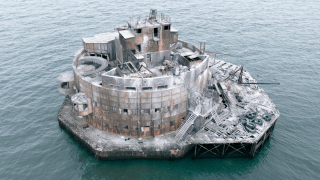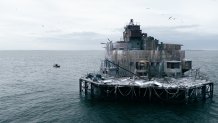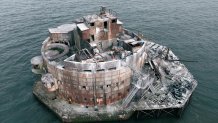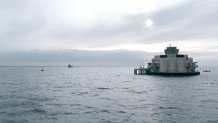
What do you do with an old sea fort when the war ends and you don't need to dedicate quite so many resources to defending crown and country?
That's a very real question in the United Kingdom, where the World-War-I-era Bull Sand Fort will go up for auction on Tuesday.
The fort is located in the Humber Estuary across the inlet from Hull, a city in the northeast part of England, and bidding will start at £50,000. That's just under $60,000 -- pretty affordable for property with so much history attached.

Get Southern California news, weather forecasts and entertainment stories to your inbox. Sign up for NBC LA newsletters.
According to auctioneer Savills, "a global real estate advisor that works across commercial, rural and residential markets" and which holds the listing for the Bull Sand Fort, the fort was constructed between 1915 and 1919, about three miles off the coast of a river inlet.
Because it was still under construction for much of WWI, it was also used "for naval sea defence" during World War II. At that point, "it was armed, besides the usual small and rapid-fire weapons, by two 6 inch guns and two 6-pounder guns. It had sufficient accommodation for a garrison of 200 men."
The Bull Sand Fort, along with another called the Haile Sand, helped defend the entrance to the river inlet "with gun batteries and an anti-submarine net of steel mesh stretched between them across the mouth of the estuary," Savills says in the listing.

In the 1950s, both of those forts were abandoned by the military.
Local
Get Los Angeles's latest local news on crime, entertainment, weather, schools, COVID, cost of living and more. Here's your go-to source for today's LA news.
The Bull Sand Fort is considered a Grade II building, which according to U.K. law means it's considered nationally important due to its history. That means it comes with extra legal protections, and "extra control over what changes can be made to a building's interior and exterior," according to the Historic England website.
For prospective buyers, that means some extra paperwork to fill out for special permits before renovations "that affect the 'special architectural or historic interest' of their home."
With three floors, including a basement and magazine below sea level, and a "central 2-storey observation tower," there's a surprising amount of space to work with -- for anyone "with the right planning consents, time and money," a spokesperson from the Savills press office told NBC4 in an emailed statement.
Attempts have been made in the past. In 2005, the Independent reported that an anti-drug charity bought the fort and obtained permission to use it as an isolated clinic, to "treat up to 150 patients using a 30-day programme similar to Alcoholics Anonymous's 12-step recovery treatment."
That project never came to fruition, and "Savills have now been asked to sell it at auction," the spokesperson said.
Other English sea forts have been transformed into luxury hotels, events venues and at least one museum.
Prospective buyers may need their own boat or private helicopter to get to the property, but once they get there, there's a supply of fresh water on-site, due to the "artesian well" within the fort.
You're also guaranteed beautiful ocean views from the external balcony and jetty.
Check out more photos of the Bull Sand Fort below:
1.

2.

3.




